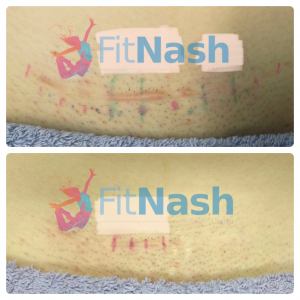Wondering what we do for C Sections? How we treat them to relieve aches and pains, or make them look better?
Read this 👇👨⚕️👨🎓🕵️♂️👇
There are two images, the first was taken after the first treatment (so there is some small improvement on what the client presented with). The second is 6 treatments later.
Whilst the images don’t tell the whole story, lets start with them, working from the left to right of the picture.
In the first picture there are three distinct areas of red, raised and hard unmalleable tissue, the scar is pretty visible along its entire length. The client didn’t like the feel of the scar, particularly the raised and puckered areas. The scar had been itching pretty much since it the birth of their child 15 months previous, and was causing tightness abdominal pain, and restricted movement.
What the scar doesn’t show is the client was also affected by breathing issues, balance issues, and gait issues, which isn’t unexpected as they also had less than optimal intrinsic core connection, or ability to build intra abdominal pressure.
This is hardly surprising give the structures that were cut through, including both conjoint tendons!
The second picture is where we are currently. Note most of the scar is invisible despite the much better lighting. The original raised and puckered areas are still visible as they are slightly redder than the surrounding tissues. BUT, they are now flat, to the point they can’t pinpoint the scar without looking. There is no pain, no itching, and no pulling on certain movements. They feel lighter, able to do much more, and have their ‘pre pregnancy flat stomach’ back again.
Their neurology is back on line, we are just finishing up some pelvic floor issues to fully optimise their breathing patterns.
We have one more session booked for some fascial work and sign off.
Many of the scars I see in clinic are dysfunctional, the distortion of the fascial tissues as a result of the cutting and suturing has a direct effect on the sensorimotor system. Caesarean sections are particularly problematic as they cause issues with the muscles of the intrinsic and extrinsic core, particularly when they catch the conjoint tendon(s). These muscles are vital as they allow us to build and maintain intra abdominal pressure, essential for safe movement, without which compensation patterns and eventually pain can set in.
The untold story relating to C sections however, is the effect on a clients emotional welfare. Not being able to maintain normal bodily function, or move without pain and discomfort, get down on the floor with their newborn, or lift them as they get older can have a huge impact, on routines, relationships, and how a client feels about their own body.
If you have a C section, or any other scar for that matter, which doesn’t feel or look like the surrounding tissue, particularly if you’ve also got some aches and pains – even if they appear unrelated – get in touch, it doesn’t take long to check these things out 😊👍🏻
Tag your friends ☺️
#FitNash #Rehab #Scars #ScarWork #Caesarean #Cesarean #CSection #Pregnancy #Surgery #Recovery #WomensHealth #ObGyn #BirthComplications #NewMum #Wellbeing #EmotionalBirthStory #NeuroScience
The scribbled out sections on the images are to protect the intellectual property rights of the techniques used to help treat scars and their associated dysfunctions.
The images are ‘stills’ taken from the homework videos the client was given throughout their treatment, which they have very kindly allowed me to use in the format.
#NKT #ID #ScoliMethod

